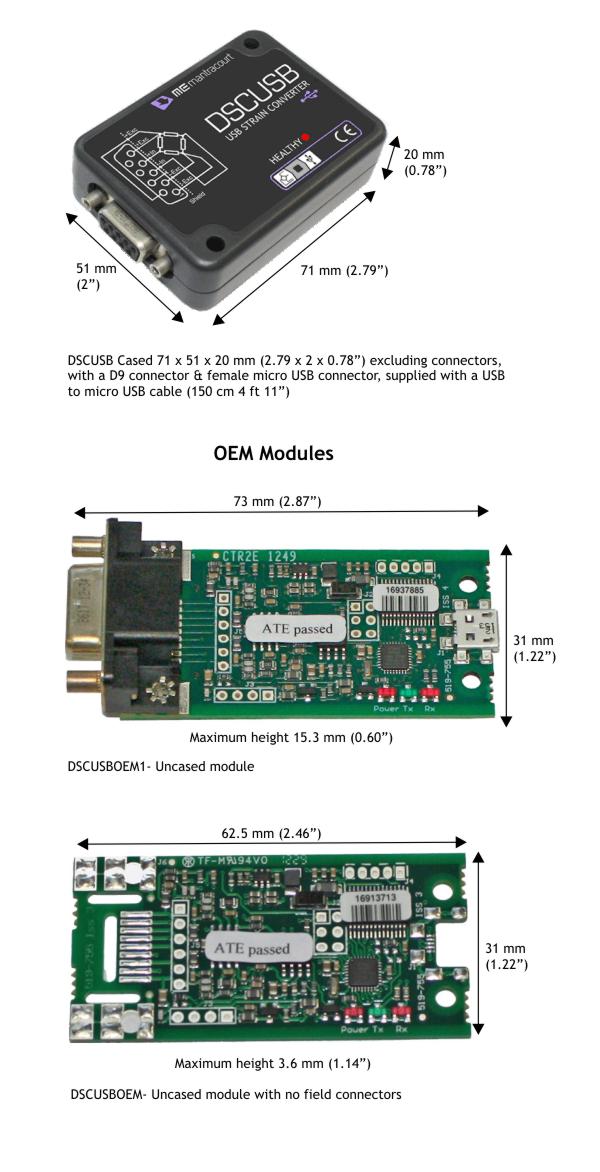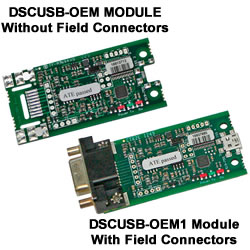DSCUSB | OEM | OEM1 | Strain Gauge to USB Convertor
- USB strain gauge interface
- High stability providing superior performance
- Optional temperature compensation
- Windows driver DLL’s available
- OEM pcb versions available
The DSCUSB OEM PCB strain gauge to USB converter is a high performance strain gauge digital signal conditioner with USB connectivity aimed at applications which require high-accuracy measurement repeat-ability.
A rugged ABS IP50 enclosure is available and makes this USB load cell converter suitable for all environments. Simply by plugging the DSCUSB into a PC, data can be extracted from most strain gauge bridge input sensors and acquired by software which allows data manipulation removing the need for amplifiers, filters & multi-meters. No additional power supply is required as the power is drawn from the USB bus.
Although ideal for 1 to 1 interface, the strain gauge to USB converter – DSCUSB, can connect with multiple sensors with the use of a suitable hub. Available in ASCII protocol, offering higher resolution and lower temperature drift.
Ideal for all strain gauge bridge based sensors including load, weight, force, torque, pressure & displacement, the device simply plugs into your PC where data can be acquired and manipulated by accompanying software.
Typical applications for the DSCUSB USB load cell signal converter will be those requiring simple sensor connectivity in desk top settings such as test & measurement, R&D and laboratory environments.
An optional temperature sensor module (DTEMP) is available which will enable an advanced 5-point temperature compensation of measurements.
The USB load cell signal converter is also available in a Case - please see product sheet for more information.
| DSCUSB High Stability Bridge Measurement | |||||
|---|---|---|---|---|---|
| Min | Typical | Max | Units | ||
| Strain Gauge Excitation System | 4 Wire | ||||
| Strain Gauge Excitation Voltage | 4.5 | 5 | 5.25 | V DC | |
| Strain Gauge Drive Capability | 80 | - | 5000 | Ohms | |
| Strain Gauge Sensitivity | -3 | 2.5 | 3 | mV/V | |
| Offset Temperature Stability | 1 | 4 | ppm/C | ||
| Gain Temperature Stability | 3 | 5 | ppm/C | ||
| Offset Stablitity with Time | 35 | 160 | ppm of FR (1) | ||
| Gain Stability with Time | 300 | ppm of FR (2) | |||
| Non Linearity before Linearization | 5 | 25 | ppm of FR | ||
| Internal Resolution | 16 Million | Counts/Divs | |||
| Resolution @ 1Hz Readings (Noise Stable) over 100s | 200,000 | Counts/Divs | |||
| Resolution @ 10Hz Readings (Noise Stable) over 100s | 120,000 | Counts/Divs | |||
| Resolution @ 100Hz Readings (Noise Stable) over 100s | 50,000 | Counts/Divs | |||
| Resolution @ 500Hz Readings (Noise Stable) over 100s | 18,000 | Counts/Divs | |||
| Signal Filter | Dynamic recursive type user programmable | ||||
| Electrical | |||||
| Supply Voltage Range | 4.25 | 5 | 5.5 | V DC | |
| Average Operational Current (normal mode) | 68 | 75 | mA* | ||
| * When connected to a 350 Ohm Load Cell | |||||
| Data Transmission | |||||
| Data Transmission Rate | 2.4 | - | 460.8 | kbps | |
| Output Cable Length | 5 | m | |||
| Communications (USB) | |||||
| The load cell to USB adaptor will communicate as a simple serial device rather than a ‘native’ USB device. Once the device is plugged into a PC and the supplied drivers are installed, the device will appear as a Virtual Serial Port to the PC. |
|||||
| Support Modules | |||||
| Instrument Explorer Software | |||||
| DSC Toolkit Software | |||||
| DSCLOG24 Software | |||||
| Environmental | |||||
| IP Rating | IP50 | ||||
| Storage Temperature | - 40 to + 85ºC | ||||
| Operating Temperature | - 40 to + 85ºC | ||||
| Relative Humidity | 95% maximum non condensing | ||||
| CE Environmental Approvals | European EMC Directive 2004/108/EC | ||||

Documents
Software
- DSCUSB Toolkit : Version 4.3.0 This toolkit allows configuration, calibration, logging and parameter management of the DSCUSB, DSCSUASC and DSCSUEASC modules.
- DSC 24 Channel Logging : Version 1.2.0 View and log data from up to 24 DSC, DLC or DSCUSB modules.
- Driver DLL DSCUSB : Version 1.1 DSCUSBDrv.DLL is a standard Windows DLL that can be used to help your own Windows PC applications communicate with DSC USB instruments DSCSUASC and DSCSUEASC.
- DSC Fixed COM Ports : This software ensures that all DSCUSB modules plugged into the PC are allocated the same COM port. This is useful for OEM scenarios where many modules are connected for production purposes.
- Instrument Explorer : Version 2 build 2.0a This software allows the user to quickly set up and start to use the digitisers and indicators that Mantracourt offers. Capabilities include event monitoring and data logging, as well as calibration and configuration.
- Q: How do I communicate with the USB device?
-
A: Using a simple ‘Virtual Com Port’, the DSCUSB communicates as if the device is connected to a serial port. The device addressing allows multiple devices.
- Q: Is temperature sensing available on the DSCUSB?
-
A: An optional temperature sensor module (DTEMP) is available which will enable an advanced 5-point temperature-compensation of measurements.
- Q: Is there Linearity compensation in the DSCUSB?
-
A: Advanced 7-point linearity compensation available as standard.
- Q: How stable is the DSCUSB device?
-
A: 10ppm/°C basic accuracy (equates to 16 bit resolution).
- Q: Are there self-diagnostics capabilities?
-
A: Continuous monitoring on the DSCUSB for faults such as strain overload, over/under-temperature, broken sensors or power failure. All fault warnings are retained on power-fail.
- Q:What are the output options of the DSCUSB?
-
A: We currenly only offer the device in ASCII protocol.
- Q: Tell me about DSCUSB low current
-
A: Functions as a ‘Low Power Device’ i.e. draws less than 100mA (one unit load) when connected to a 350 Ohm Bridge.
 Required Items and Optional Accessories...
Required Items and Optional Accessories...
